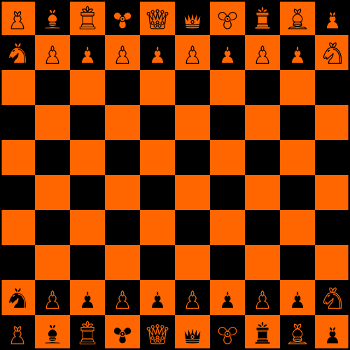
“If scientific theories are correct it is more of an honor to lose at chess than win,” mused Edgar Rice Burroughs in his diary on Jan. 3, 1921. “I do not recall ever having lost a chess game — though I have played but few times.”
Perhaps inspired, he invented a Martian variant of the game, Jetan, for his novel The Chessmen of Mars, published the following spring. Played with alien pieces on a 10×10 board, the game underlies a climactic scene in which living players fight to the death on an oversize board.
A few months after the novel’s appearance, Burroughs received a letter from Elston B. Sweet, a convict at Leavenworth, who with a fellow prisoner had carved a full set of pieces for Jetan. “We have not only played dozens of games between us,” he wrote, “but have succeeded in making the game a favorite among several other prisoners.” When other readers expressed similar interest, Burroughs summarized the rules of the game in an appendix to the novel.
In a 1968 collection of chess variations, John Gollon praises Jetan as “quite good — very playable and entertaining.” He includes this sample game between himself (orange) and J. Miller (black):
1. (T) A2-B4 (T)A9-B7
2. (W) A1-A3 (W) A10-A8
3. (Pd) B1-B3 (Pd) B10-B8
4. (Pa) C2-D3 (Pa) C9-D8
5. (D) C1-C4 (D) C10-C7
6. (O) G1-D4 (O) G10-D7
7. (D) C4-C7X (D) (Pa)D8-C7X (D)
8. (Pa) B3-D5 (O) D7-G8
9. (Pa) D5-B7X (T) (Pa) C7-B7X (Pd)
10. (O) D4-G5 (Pa) F7-F8
11. (Pa) H2-G3 (Pa) H9-I8
12. (D) H1-H4 (D) H10-H7
13. (Pd) I1-I3 (Pa) I7-J8
14. (T) J2-I4 (C) F10-F7
15. (D) H4-H7X (D) (Pa) I8-H7X (D)
16. (Pa) E2-E3 (O) D10-G7
17. (Pd) I3-I5 (O) G7-D6
18. (O) D1-E4 (O) D6-G5X (O)
19. (T) I4-G5X (O) (C) F7-I5X (Pd)
20. (Pa) G3-G4 (C) I5-I2X (Pa)
21. (P) F1-C1 (C) I2-J1X (W)
22. (T) G5-H7X (Pa) (O) G8-H7X (T)
23. (O) E4-H7X (O) (P) E10-C9
24. (O) H7-I10X (Pd) (T) I9-I7
25. (C) E1-E4 (W) J10-I9
26. (C) E4-D7 (P) C9-F1
27. (C) D7-F4
“Black’s Princess ‘escaped’ into certain capture — no matter where she moves, she will be taken.”
